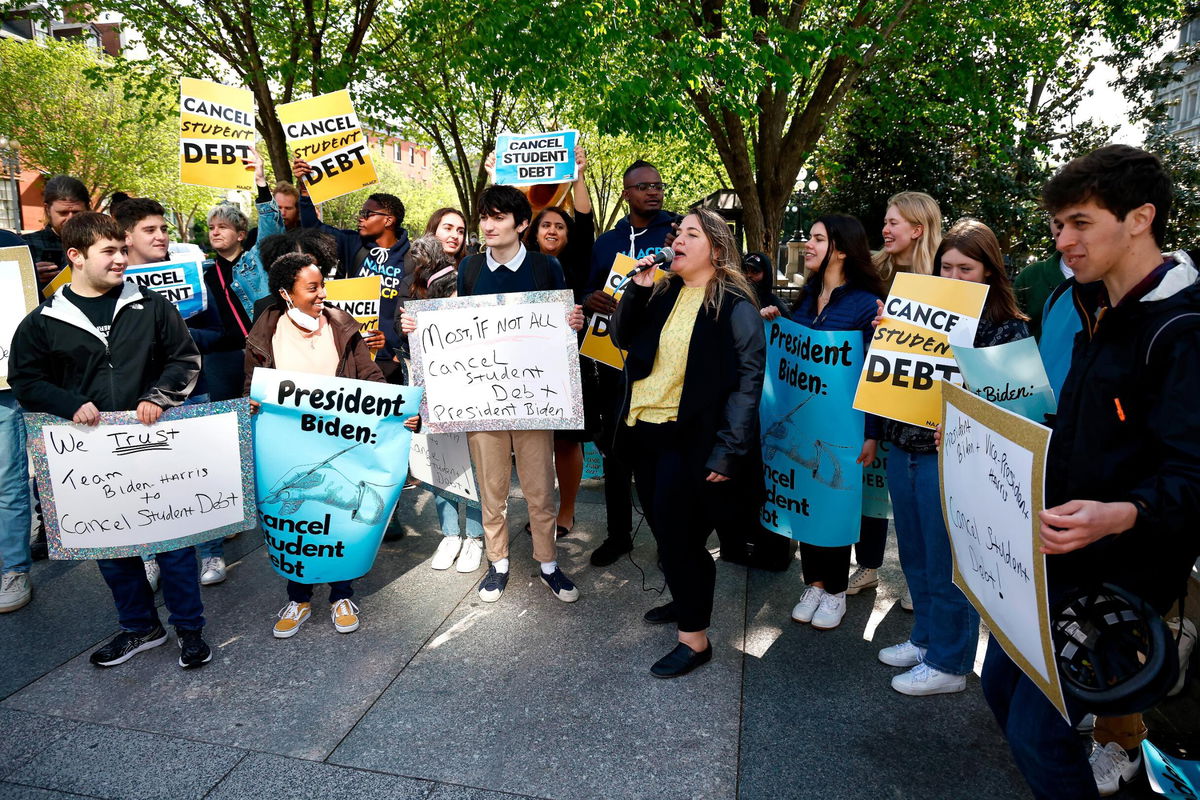Here’s who could benefit if Biden cancels $10,000 in student loan debt per borrower

Melissa Byrne joins student debtors to once again call on President Biden to cancel student debt at an early morning action outside the White House with a brass band on April 27 in Washington
By Katie Lobosco, CNN
President Joe Biden is taking a “hard look” at canceling some federal student loan debt, but even a broad forgiveness plan may leave out some of the 43 million borrowers.
The President is planning to announce his decision on Wednesday, CNN has learned.
Biden has indicated that if he does take action to provide more student loan debt forgiveness, he may limit the relief to $10,000 per person, as well as exclude wealthier borrowers.
His administration has already canceled nearly $32 billion of the $1.6 trillion in outstanding federal student debt by expanding existing forgiveness programs for public-sector workers, disabled borrowers and students who were defrauded by for-profit colleges. In addition, he’s extended the pandemic-related pause on student loan payments several times.
But those actions fall short of a campaign pledge Biden made to more broadly cancel student debt. He’s also facing pressure to do more from other Democrats who are urging him to cancel $50,000 per borrower.
Here’s what we know so far about who could benefit if the President takes steps to cancel more student loan debt:
Relief for those earning less than $125,000
Excluding borrowers who earn more than a certain amount is one way Biden could narrow student debt relief.
White House officials are leaning toward canceling $10,000 in debt for every borrower who earns less than $125,000 a year, CNN reported earlier this week.
Earlier this year, then-White House press secretary Jen Psaki said the President is using his campaign comments about providing student loan forgiveness to individuals making less than $125,000 a year as a frame for his current considerations.
His campaign proposal called for immediately canceling a minimum of $10,000 in student debt per person as a response to the pandemic, as well as forgiving all undergraduate tuition-related federal student debt from two- and four-year public colleges and universities for those borrowers earning up to $125,000 a year.
How many households could benefit?
About 19% of households that have total incomes below $125,000 have student loan debt, according to an analysis done earlier this year by Matthew Chingos, vice president of education data and policy at the Urban Institute. He based the estimation on the 2019 Survey of Consumer Finances conducted by the Federal Reserve.
That means about 81% of households who earn less than $125,000 a year don’t have student loan debt and would not see a benefit if Biden takes new action.
Most households would still not benefit even if the President did not put an income threshold in place. Only about 18% of households with incomes above $125,000 have student debt.
How much debt could be canceled?
Biden has consistently resisted political pressure to cancel $50,000 per borrower. In late April, he reiterated that if he did provide additional loan forgiveness, it would not be as much as a $50,000 reduction.
The White House has long maintained that the President would support canceling $10,000 per borrower.
The Penn Wharton Budget Model estimates that canceling $10,000 for borrowers earning less than $125,000 a year would cost the government around $298 billion.
Chingos estimated earlier this year that the action would result in forgiving a total of $277 billion in student loan debt.
(He assumed that the relief gradually phases out for both married and single borrowers earning between $75,000 and $125,000 a year. That means that borrowers earning less than $75,000 a year would receive $10,000 in forgiveness and the benefit gets smaller as incomes increase, leaving those earning more than $125,000 a year without any debt relief.)
Who would see the biggest benefit?
The Penn Wharton Budget Model also breaks down the share of forgiven debt by income group assuming that $10,000 is canceled for borrowers earning less than $125,000 per year and households earning less than $250,000 a year.
It found that one-third of the canceled dollars would go to households who earn less than $50,795 a year. A little more than half of the debt relief would go to those earning between $50,795 and $141,096.
Roughly 14% of the canceled dollars would go to households earning more than $141,096 a year.
Forgiveness by race
Advocates for student debt cancellation argue that it would help close the racial wealth gap, because Black students are more likely to take on student debt, borrow larger amounts and take longer paying them off than their White peers.
But economist Adam Looney, a nonresident senior fellow at the Brookings Institution, argues that there are better ways to address the racial wealth gap because relatively fewer Black students go to college.
Chingos’ model found that 62% of the canceled student loan dollars would go to White borrowers while 25% would go to Black borrowers if Biden canceled up to $10,000 for those earning less than $125,000 a year.
This story has been updated with additional information.
The-CNN-Wire
™ & © 2022 Cable News Network, Inc., a Warner Bros. Discovery Company. All rights reserved.